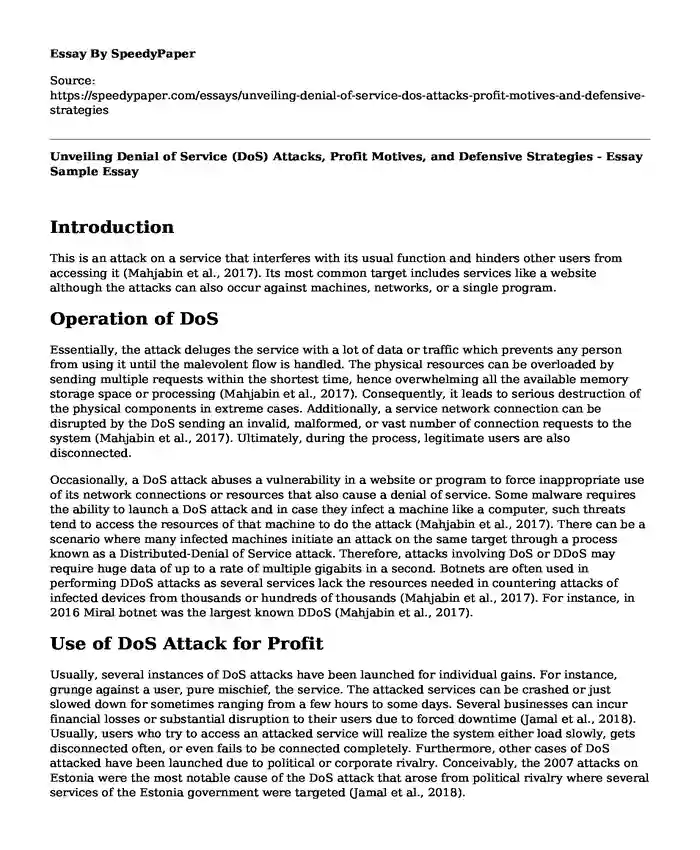
| Type of paper: | Essay |
| Categories: | Computer science Software Technology |
| Pages: | 3 |
| Wordcount: | 682 words |
Introduction
This is an attack on a service that interferes with its usual function and hinders other users from accessing it (Mahjabin et al., 2017). Its most common target includes services like a website although the attacks can also occur against machines, networks, or a single program.
Operation of DoS
Essentially, the attack deluges the service with a lot of data or traffic which prevents any person from using it until the malevolent flow is handled. The physical resources can be overloaded by sending multiple requests within the shortest time, hence overwhelming all the available memory storage space or processing (Mahjabin et al., 2017). Consequently, it leads to serious destruction of the physical components in extreme cases. Additionally, a service network connection can be disrupted by the DoS sending an invalid, malformed, or vast number of connection requests to the system (Mahjabin et al., 2017). Ultimately, during the process, legitimate users are also disconnected.
Occasionally, a DoS attack abuses a vulnerability in a website or program to force inappropriate use of its network connections or resources that also cause a denial of service. Some malware requires the ability to launch a DoS attack and in case they infect a machine like a computer, such threats tend to access the resources of that machine to do the attack (Mahjabin et al., 2017). There can be a scenario where many infected machines initiate an attack on the same target through a process known as a Distributed-Denial of Service attack. Therefore, attacks involving DoS or DDoS may require huge data of up to a rate of multiple gigabits in a second. Botnets are often used in performing DDoS attacks as several services lack the resources needed in countering attacks of infected devices from thousands or hundreds of thousands (Mahjabin et al., 2017). For instance, in 2016 Miral botnet was the largest known DDoS (Mahjabin et al., 2017).
Use of DoS Attack for Profit
Usually, several instances of DoS attacks have been launched for individual gains. For instance, grunge against a user, pure mischief, the service. The attacked services can be crashed or just slowed down for sometimes ranging from a few hours to some days. Several businesses can incur financial losses or substantial disruption to their users due to forced downtime (Jamal et al., 2018). Usually, users who try to access an attacked service will realize the system either load slowly, gets disconnected often, or even fails to be connected completely. Furthermore, other cases of DoS attacked have been launched due to political or corporate rivalry. Conceivably, the 2007 attacks on Estonia were the most notable cause of the DoS attack that arose from political rivalry where several services of the Estonia government were targeted (Jamal et al., 2018).
Defense against DoS Attack
Initially, there were a variety of technological skills and knowledge required to launch a DoS attack. Hence, it was aimed at limiting the number of people who could use DoS as they must be skilled, or those who were able to hire individuals with the required skills (Jamal et al., 2018). However, there are currently simple and modified tools and programs that are sold online in criminal forums. They allow unskilled users to launch a DoS attack, thus becoming more feasible for criminals like cyber-attack that is very rampant in society (Jamal et al., 2018). At the same time, other parties can easily maneuver ways of disrupting online services.
In conclusion, several major online services have implemented different countermeasures to handle the overwhelming floods of data or traffic. Some of such strategies include sinholding, traffic filtering and analysis, and the use of IP-based prevention methods. Unfortunately, the techniques are prohibitively costly for many smaller services. Thus, there must be adequate defenses to prevent exposing resources from the same attack causing them to crash repeatedly.
References
Jamal, T., Haider, Z., Butt, S. A., & Chohan, A. (2018). Denial of service attack in cooperative networks. arXiv preprint arXiv:1810.11070. https://arxiv.org/abs/1810.11070
Mahjabin, T., Xiao, Y., Sun, G., & Jiang, W. (2017). A survey of a distributed denial-of-service attack, prevention, and mitigation techniques. International Journal of Distributed Sensor Networks, 13(12), 1550147717741463. https://journals.sagepub.com/doi/full/10.1177/1550147717741463
Cite this page
Unveiling Denial of Service (DoS) Attacks, Profit Motives, and Defensive Strategies - Essay Sample. (2024, Jan 24). Retrieved from https://speedypaper.com/essays/unveiling-denial-of-service-dos-attacks-profit-motives-and-defensive-strategies
Request Removal
If you are the original author of this essay and no longer wish to have it published on the SpeedyPaper website, please click below to request its removal:
- Free Essay Example: Internet for Young People
- Free Essay on Evolution of IT in Healthcare
- Free Essay: Features of Amazon E-Commerce Website
- Essay Sample on How Memes Appear and Disappear
- What Decision Should Self-Driving Vehicles Make? - Essay Sample
- Free Essay on Amazon.com Inc. Competitive Forces Analysis and Value Chain Models
- Essay Sample on Current Trends in Computer Science and IT
Popular categories




